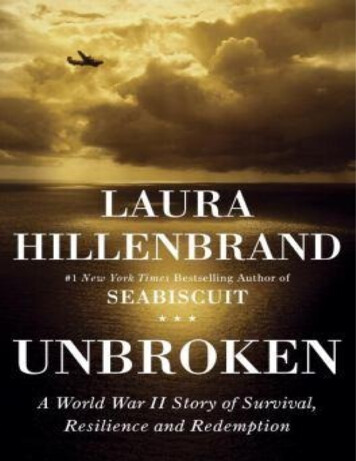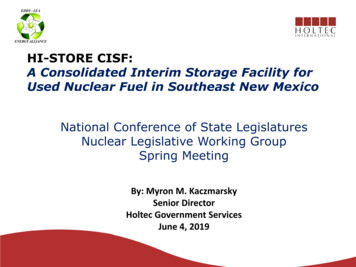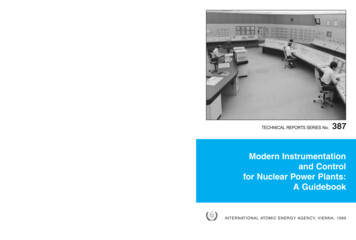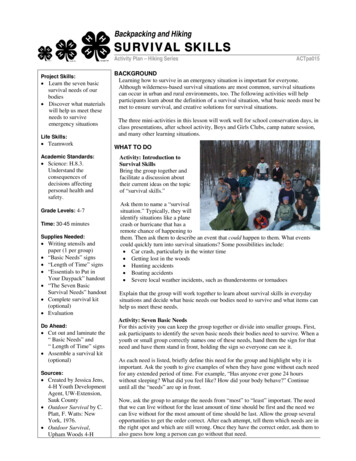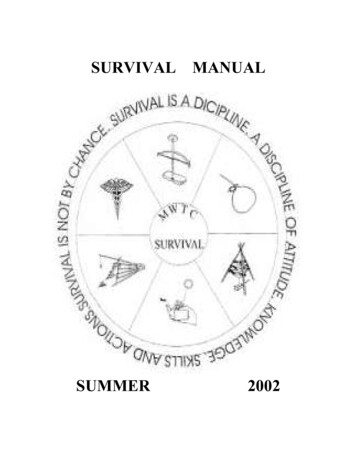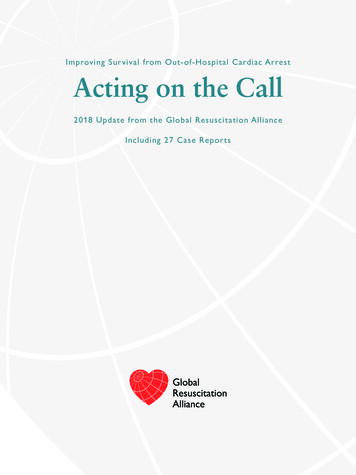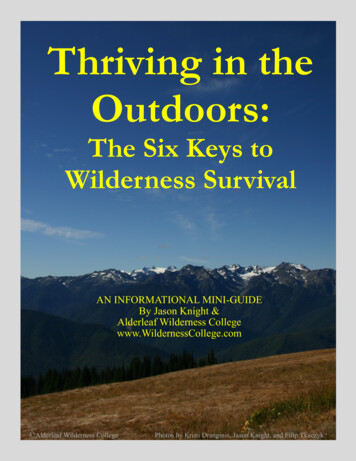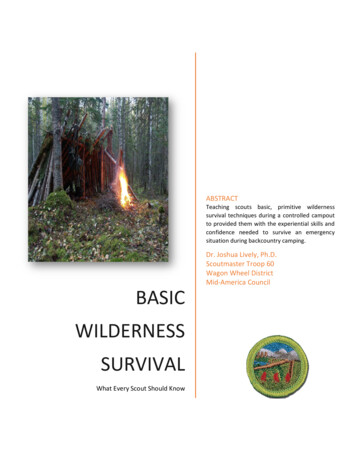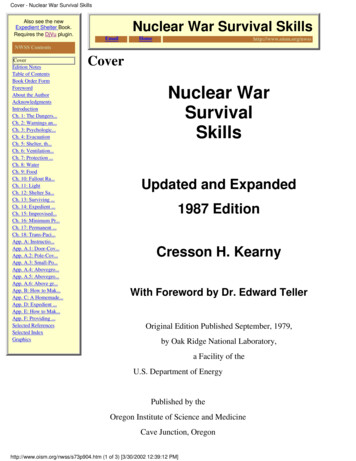
Transcription
Cover - Nuclear War Survival SkillsAlso see the newExpedient Shelter Book.Requires the DjVu plugin.Nuclear War Survival SkillsEmailHomehttp://www.oism.org/nwssNWSS ContentsCoverEdition NotesTable of ContentsBook Order FormForewordAbout the AuthorAcknowledgmentsIntroductionCh. 1: The Dangers.Ch. 2: Warnings an.Ch. 3: Psychologic.Ch. 4: EvacuationCh. 5: Shelter, th.Ch. 6: Ventilation.Ch. 7: Protection .Ch. 8: WaterCh. 9: FoodCh. 10: Fallout Ra.Ch. 11: LightCh. 12: Shelter Sa.Ch. 13: Surviving .Ch. 14: Expedient .Ch. 15: Improvised.Ch. 16: Minimum Pr.Ch. 17: Permanent .Ch. 18: Trans-Paci.App. A: Instructio.App. A.1: Door-Cov.App. A.2: Pole-Cov.App. A.3: Small-Po.App. A.4: Abovegro.App. A.5: Abovegro.App. A.6: Above gr.App. B: How to Mak.App. C: A Homemade.App. D: Expedient .App. E: How to Mak.App. F: Providing .Selected ReferencesSelected IndexGraphicsCoverNuclear WarSurvivalSkillsUpdated and Expanded1987 EditionCresson H. KearnyWith Foreword by Dr. Edward TellerOriginal Edition Published September, 1979,by Oak Ridge National Laboratory,a Facility of theU.S. Department of EnergyPublished by theOregon Institute of Science and MedicineCave Junction, Oregonhttp://www.oism.org/nwss/s73p904.htm (1 of 3) [3/30/2002 12:39:12 PM]
Cover - Nuclear War Survival SkillsCopyright (c) 1986 by Cresson H. KearnyCresson H. Kearny's additions to the Oak Ridge National Laboratory original 1979 edition are the onlyparts covered by this copyright, and are printed in this type print to distinguish these additions from theoriginal uncopyrighted parts. The uncopyrighted parts are printed in a different type of print (like this).No part of the added copyrighted parts (except brief passages that a reviewer may quote in a review) maybe reproduced in any form unless the reproduced material includes the following two sentences:Copyright (c) 1986 by Cresson H. Kearny. The copyrighted material may be reproduced withoutobtaining permission from anyone, provided: (1) all copyrighted material is reproduced full-scale (exceptfor microfiche reproductions), and (2) the part of this copyright notice within quotation marks is printedalong with the copyrighted material."First printing May 1987Second printing November 1988Third printing September 1990ISBN 0-942487-01-XLibrary of Congress Catalogue Card Number 87-60790Book Page: 0Electronic EditionThe Electronic Edition of Nuclear War Survival Skills was prepared and published by Arnold Jagt.The book was scanned using an HP ScanJet IIc, OCR (optical character recognition) using Xerox'TextBridge, and cleaned up using AmiPro for the text and a variety of graphic packages for theillustrations and photographs. The purpose of this file is to provide for "on demand publishing" of thecontents first, and as an online document second.Please Note: Due to the limitations of this online version the KFM Templates and other illustrations arenot entirely reliable and should be obtained from the printed version. Send 19.50 to: Oregon Institute ofScience and Medicine, P.O. Box 1279 , Cave Junction, Oregon 97523.For Surviving Global Warming Enviros see: www.oism.org/pproject an Anti-Global Warming PetitionProject.See the newsletter Access to Energy by Art Robinson at www.accesstoenergy.com for more information.http://www.oism.org/nwss/s73p904.htm (2 of 3) [3/30/2002 12:39:12 PM]
Cover - Nuclear War Survival SkillsCopyright 2000 Nuclear War Survival Skillshttp://www.oism.org/nwss/s73p904.htm (3 of 3) [3/30/2002 12:39:12 PM]
Edition Notes - Nuclear War Survival SkillsAlso see the newExpedient Shelter Book.Requires the DjVu plugin.Nuclear War Survival SkillsEmailHomehttp://www.oism.org/nwssNWSS ContentsCoverEdition NotesTable of ContentsBook Order FormForewordAbout the AuthorAcknowledgmentsIntroductionCh. 1: The Dangers.Ch. 2: Warnings an.Ch. 3: Psychologic.Ch. 4: EvacuationCh. 5: Shelter, th.Ch. 6: Ventilation.Ch. 7: Protection .Ch. 8: WaterCh. 9: FoodCh. 10: Fallout Ra.Ch. 11: LightCh. 12: Shelter Sa.Ch. 13: Surviving .Ch. 14: Expedient .Ch. 15: Improvised.Ch. 16: Minimum Pr.Ch. 17: Permanent .Ch. 18: Trans-Paci.App. A: Instructio.App. A.1: Door-Cov.App. A.2: Pole-Cov.App. A.3: Small-Po.App. A.4: Abovegro.App. A.5: Abovegro.App. A.6: Above gr.App. B: How to Mak.App. C: A Homemade.App. D: Expedient .App. E: How to Mak.App. F: Providing .Selected ReferencesSelected IndexGraphicsEdition NotesTopPreviousNextUpdated and Expanded 1987 Edition Updated and Expanded 1987Edition Introduction to: Nuclear WarSurvival SkillsThe purpose of this book is to provide Americans and other unprepared peoplewith information and self-help instructions that will significantly increase theirchances of surviving a nuclear attack. It brings together field- tested instructionsthat, if followed by a large fraction of Americans during a crisis that precedes anattack, could save millions of lives. The author is convinced that thevulnerability especially of Americans to nuclear threat or attack must bereduced and that the wide dissemination of the information contained in thisbook will help preserve peace with freedom.Underlying the advocacy of Americans learning these down-to-earth survivalskills is the belief that if one prepares for the worst, the worst is less likely tohappen. Effective American civil defense preparations would reduce theprobability of nuclear blackmail and war. Yet in our world of increasingdangers, it is significant that the United States spends much less per capita oncivil defense than many other countries. The United States' annual funding isabout 50 cents per capita, and only a few cents of this is spent on war-relatedcivil defense. Unless U.S. civil defense policies are improved, you are unlikelyto receive from official sources much of the survival information given in thisbook.Over 400,000 copies of the Oak Ridge National Laboratory original 1979edition of Nuclear War Survival Skills have been sold by various privatepublishers. A few additions and modifications, some helpful and others harmful,were made in several of these private printings. This updated and expandededition is needed because of changes in nuclear weapons and strategies between1979 and 1987, and because of improvements in self-help survival equipmentand instructions.The 1987 edition provides current information on how the Soviet Union's continuing deployment ofsmaller, more accurate, more numerous warheads should affect your shelter- building and evacuationplans.In the first chapter the myths and facts about the consequences of a massive nuclear attack are discussed.Two post-1979 myths have been added: the myth of blinding post-attack increased ultra-violet sunlight,and the myth of unsurvivable "nuclear winter" - along with refuting facts.http://www.oism.org/nwss/s73p905.htm (1 of 3) [3/30/2002 11:58:13 AM]
Edition Notes - Nuclear War Survival SkillsA new chapter, "Permanent Family Fallout Shelters for Dual Use", has been added, because the authorhas received many requests for instructions for building permanent small shelters better and lessexpensive than those described in official civil defense hand-outs. Another new chapter, "Trans-PacificFallout" tells how to reduce radiation dangers that you will face if one or more nations use nuclearweapons, but none are exploded on America.Improved instructions are given for making and using a KFM, based on the findings of numerousbuilders since 1979. (The KFM still is the only accurate and dependable fallout radiation meter thatmillions of average people can make for themselves in a few hours, using only common householdmaterials - if they have these improved instructions with patterns.) Field-tested instructions for easilymade Directional Fans, the simplest means for pumping air, have been added to the "Ventilation andCooling of Shelters" chapter. Also included in this book are scores of other new facts and updatingslikely to help save lives if nuclear war strikes.A new appendix gives instructions for a home makeable Plywood Double-Action Piston Pump, inspiredby a wooden air pump the author saw being used in China in 1982.This first-of-its-kind book is primarily a compilation and summary of civil defense measures developedat Oak Ridge National Laboratory and elsewhere over the past 24 years, and field tested by typicaluntrained Americans in many states, from Florida to Washington. The reader is urged to make at leastsome of these low-cost preparations before a crisis arises. The main emphasis, however, is on survivalpreparations that could be made in the last few days of a worsening crisis.The author wrote the original, uncopyrighted Nuclear War Survival Skills while working as aresearch engineer at Oak Ridge National Laboratory. As a result, he has no proprietary rights andhas gotten nothing but satisfaction from past sales. Nor will he gain materially from future sales, ascan be judged by reading his copyright notice covering this edition. Civil defense professionals andothers concerned with providing better self-help survival information can reproduce parts or all ofthis 1987 edition without getting permission from anyone, provided they comply with the terms ofthe copyright notice.Book Page: 1TopPreviousNextIntroduction to: Nuclear War Survival Skillsby Edward TellerJanuary 14, 1994With the collapse of the Soviet Union, the unimaginable catastrophe of all out nuclear war has becometruly im- probable. At the same time this unexpected event taught a lesson: being prepared for troublemay help to eliminate the source of trouble. Perhaps, after all, the atomic age might become a happy age.Possible but not yet probable. Proliferation of nuclear weapons is more of a danger than ever before. Butthe danger is now different. What may happen is still horrible but it is no longer a catastrophe beyond ourpower of de- scribing it or preventing it.http://www.oism.org/nwss/s73p905.htm (2 of 3) [3/30/2002 11:58:13 AM]
Edition Notes - Nuclear War Survival SkillsAs long as the superpowers faced each other with tens of thousands of megaton-class weapons, anydefense seemed insufficient. It was a palliative of unclear war. It played more of a role as part of thedeterrent. To many of us it seemed to be a necessity. But in efforts to convince the general public wemade little progress. The question could not be resolved by reason alone.The problem of ideological conflict is disappearing. The problem of a violent dictator is still with us.With weap- ons of mass destruction he could do enormous damage. Furthermore, the proliferation ofballistic missiles is not a pos- sibility but a frightening and growing reality. But we are now no longerfacing tens of thousands of weapons. We need to worry about at most hundreds. Defense, therefore, hasbecome a rational possibility.But if defense is possible, it is also most important for four connected but, at the same time, distinctreasons. One is that in the case of war defense may save many thousands, maybe even millions of lives. Ido not disagree with those who say that the main problem is to prevent war itself. I do disagree whenprevention of war is considered the only problem.The second reason is that defense helps to prevent proliferation of weapons of aggression. If defense isne- glected these weapons of attack become effective. They become available and desirable in the eyes ofan imperialist dictator, even if his means are limited. Weapons of mass destruction could becomeequalizers between nations big and small, highly developed and primitive, if defense is neglected. Ifdefense is developed and if it is made available for general prevention of war, weapons of aggression willbecome less desirable. Thus defense makes war itself less probable. The third reason is of a most generalcharacter. One psychological defense mechanism against danger is to forget about it. This attitude is ascommon as it is disastrous. It may turn a limited danger into a fatal difficulty.The last and most important reason is that the world has become thoroughly interdependent and the timehas come for the positive use of this interdependence. International cooperation is obviously difficult. Itlacks any tradi- tion. It is best started by modest activities that are obviously in everyone's interest.War-prevention by defense seems to be a good candidate for such cooperation. This would beparticularly true if the effort would be both modest and effective. This book is an excellent example of aninternational initiative that with a minimal effort could have a maximal beneficial effect. It describessimple procedures of individual defensive measures which should be used in many areas of dangerincluding those where it is wrongly believed that defense is impossible. It can be used in advancedcountries and in countries at an early stage of development. Electronics makes the book availablethroughout the world.This book will not satisfy the demands of those who are interested only in final solutions. Indeed, I donot believe that final solutions exist. The more important and difficult a problem is the more it becomesevident that the answer lies in a careful development consisting of small steps. This book prepares us,throughout the world, for one of the small steps that must be taken if the twenty-first century is to escapethe curse of war.Copyright 2000 Nuclear War Survival Skillshttp://www.oism.org/nwss/s73p905.htm (3 of 3) [3/30/2002 11:58:13 AM]
Table of Contents - Nuclear War Survival SkillsAlso see the newExpedient Shelter Book.Requires the DjVu plugin.Nuclear War Survival SkillsEmailHomehttp://www.oism.org/nwssNWSS ContentsCoverEdition NotesTable of ContentsBook Order FormForewordAbout the AuthorAcknowledgmentsIntroductionCh. 1: The Dangers.Ch. 2: Warnings an.Ch. 3: Psychologic.Ch. 4: EvacuationCh. 5: Shelter, th.Ch. 6: Ventilation.Ch. 7: Protection .Ch. 8: WaterCh. 9: FoodCh. 10: Fallout Ra.Ch. 11: LightCh. 12: Shelter Sa.Ch. 13: Surviving .Ch. 14: Expedient .Ch. 15: Improvised.Ch. 16: Minimum Pr.Ch. 17: Permanent .Ch. 18: Trans-Paci.App. A: Instructio.App. A.1: Door-Cov.App. A.2: Pole-Cov.App. A.3: Small-Po.App. A.4: Abovegro.App. A.5: Abovegro.App. A.6: Above gr.App. B: How to Mak.App. C: A Homemade.App. D: Expedient .App. E: How to Mak.App. F: Providing .Selected ReferencesSelected IndexGraphicsTable of ContentsForeword by Dr. Edward TellerAbout the Author by Dr. Eugene P. WignerAcknowledgementsIntroduction6101214Chapter 1 The Dangers from Nuclear Weapons: Myths and FactsChapter 2 Psychological PreparationsChapter 3 Warnings and CommunicationsChapter 4 EvacuationChapter 5 Shelter, the Greatest NeedChapter 6 Ventilation and Cooling of SheltersChapter 7 Protection Against Fires and Carbon MonoxideChapter 8 WaterChapter 9 FoodChapter 10 Fallout Radiation Meters213133404965818595119Chapter 11 LightChapter 12 Shelter Sanitation and Preventive MedicineChapter 13 Surviving Without DoctorsChapter 14 Expedient Shelter FurnishingsChapter 15 Improvised Clothing and Protective ItemsChapter 16 Minimum Pre-Crisis PreparationsChapter 17 Permanent Family Fallout Shelters for Dual UseChapter 18 Trans-Pacific Fallout127130136149156164167188AppendicesA Instructions for Six Expedient Fallout SheltersA.1 Door-Covered Trench ShelterA.2 Pole-Covered Trench ShelterA.3 Small-Pole ShelterA.4 Aboveground, Door-Covered ShelterA.5 Aboveground, Ridgepole ShelterA.6 Above ground, Crib-Walled ShelterB How to Make and Use a HomemadeShelter-Ventilating Pump, the KAPC A HOMEMADE FALLOUT METER, THE K.F.M. - HOW TOMAKE AND USE ITD Expedient Blast SheltersE How to Make and Use a Homemade Plywood Double Action PistonPump and Filterhttp://www.oism.org/nwss/s73p906.htm (1 of 2) [3/30/2002 11:58:21 AM]193198203208215221228234253284300
Table of Contents - Nuclear War Survival SkillsF Means for Providing Improved Natural Ventilation and Daylight to aShelter with an Emergency ExitSelected ReferencesSelected IndexCopyright 2000 Nuclear War Survival Skillshttp://www.oism.org/nwss/s73p906.htm (2 of 2) [3/30/2002 11:58:21 AM]319323326
Book Order Form - Nuclear War Survival SkillsAlso see the newExpedient Shelter Book.Requires the DjVu plugin.Nuclear War Survival SkillsEmailHomehttp://www.oism.org/nwssNWSS ContentsCoverEdition NotesTable of ContentsBook Order FormForewordAbout the AuthorAcknowledgmentsIntroductionCh. 1: The Dangers.Ch. 2: Warnings an.Ch. 3: Psychologic.Ch. 4: EvacuationCh. 5: Shelter, th.Ch. 6: Ventilation.Ch. 7: Protection .Ch. 8: WaterCh. 9: FoodCh. 10: Fallout Ra.Ch. 11: LightCh. 12: Shelter Sa.Ch. 13: Surviving .Ch. 14: Expedient .Ch. 15: Improvised.Ch. 16: Minimum Pr.Ch. 17: Permanent .Ch. 18: Trans-Paci.App. A: Instructio.App. A.1: Door-Cov.App. A.2: Pole-Cov.App. A.3: Small-Po.App. A.4: Abovegro.App. A.5: Abovegro.App. A.6: Above gr.App. B: How to Mak.App. C: A Homemade.App. D: Expedient .App. E: How to Mak.App. F: Providing .Selected ReferencesSelected IndexGraphicsBook Order FormTopPreviousNextNuclear War Survival Skills Nuclear War Survival SkillsJungle Snafus and RemediesBiographical Information andUnique QualificationsThis book should be in every American home and place of business. It shouldbe a part of all civilian and military defense preparations. In this nuclear age,prior preparation and knowledge are the primary elements of survival duringnuclear war, biological and chemical attack, and other man-made or naturaldisasters. This book provides that essential knowledge.It is published on a non-profit, non-royalty basis by the Oregon Institute ofScience and Medicine (a 501 [c] [3] public foundation). These low prices alsoare made possible by continuing donations to the Oregon Institute of Scienceand Medicine given specifically to help meet the cost of publication and widedistribution of this updated and enlarged edition.Nuclear War Survival Skills is available postage paid within the United States atthe following prices:1 copy 19.755 copies 85.0010 copies 150.00100 copies 1250.00larger quantities - quoted on requestI understand I will receive, as a bonus, the two latest issues of Access to Energy.Books are sent book rate (allow 4-6 weeks for delivery). Include an extra 35for express delivery on a single copy.Please send me:Nuclear War Survival Skills Books: copiesI enclose payment of .Please send me more information about civil defense .I also am enclosing a tax-deductible contribution in the amount of .http://www.oism.org/nwss/s73p908.htm (1 of 6) [3/30/2002 11:58:28 AM]
Book Order Form - Nuclear War Survival SkillsNameAddressCity, State, ZipOregon Institute of Science and Medicine, P.O. Box 1279 , Cave Junction, Oregon 97523The Oregon Institute of Science and Medicine, which distributes extensive written, audio, and videoinformation on expedient and permanent civil defense procedures and preparations, has produced a seriesof four video tapes in which the field tested instructions in Nuclear War Survival Skills and facts aboutnuclear weapons effects are demonstrated by civil defense volunteers including demonstrations andexplanations by Cresson H. Kearny.Shelter construction and ventilation, water purification, food preparation, radiation monitoring and manyother life-saving procedures - these essential survival skills are performed just as they would be to savelives in a real nuclear emergency. This is six hours of video viewing that should be experienced by everyAmerican family.Part 1: Expedient Blast and Radiation Shelters (102 minutes)Part 2: Shelter Ventilation and Various Other Survival Skills (78 minutes)Part 3: Home-makeable and Commercial Fallout Radiation Meters (117 minutes)Part 4: Nuclear War Facts as Told to Teenagers (74 minutes)Complete Set - Four parts - Four tapes: 95.00 VHS 105.00 BetaEach Tape Alone: 29.50 VHS 32.00 BetaNuclear War Survival Skills Video Tapes:Part 1: 29.50 VHS 32.00 Beta Part 2: 29.50 VHS 32.00 BetaPart 3: 29.50 VHS 32.00 Beta Part 4: 29.50 VHS 32.00 BetaSet of All Four Tapes: 95.00 VHS 105.00 BetaI enclose payment of .Please send me more information about civil defense .I also am enclosing a tax-deductible contribution in the amount of .NameAddressCity, State, Ziphttp://www.oism.org/nwss/s73p908.htm (2 of 6) [3/30/2002 11:58:28 AM]
Book Order Form - Nuclear War Survival SkillsOregon Institute of Science and Medicine, P.O. Box 1279 , Cave Junction, Oregon 97523Book Page: 3TopPreviousNextJungle Snafus and Remediesby Cresson KearnyThis is a new book recently published by the Oregon Institute of Science and Medicine. Here are somereviews:"Throughout the military history of the American poeple, the qualities that have contributed most towinning battles have been the ability and the willingness of its combat leaders to innovate and solveunexpected problems with ingenuity and creativity. Jungles Sanfus . and Remedies provides anamazing revelation of first hand stories and anecdotes that enable the reader to gain ideas and examplesof how imaginative thinking by combat leaders can avoid disasters, save lives, and win battles. The bookis a fun read and covers many areas unrelated to jungles. I strongly recommend that all leaders,especially those in infantry and Special Operations units, read this fascinating collection of combatwisdom.”John K. SinglaubMajor General U.S. Army (Ret.)World-ranging fighter in defense of freedom"This is the record of a large part of a lifetime devoted to detecting things that went wrong, often fatally,for the foot-slogging soldier in America's twentieth century wars, and inventing canny ways to set themright. This anecdotally rich work is essential for soldiers who would like a better chance if there is a nexttime, and interesting for those who merely enjoylearning new things."Howard K. SmithOutstanding war correspondentand TV news commentator“This book includes descriptions of much of the combat-proven equipment, ranging from lightweightbreath-inflated boats and individual flotation devices to cool mosquito-protective uniforms, that againshould be produced and issued to American soldiers. Teams from my Jungle Platoon needed suchequipment when reconnoitering some 40 Japanese-held islands and destroying installations. Nor wouldall 11 Rangers of the team I commanded have been drowned off Omaha Beech had they had thebreath-inflated bladders issued late in WWII to many thousands of our soldiers fighting Japaneseinvaders.”Geroge C. Fergusonwho was awarded 12 PurpleHearts before being made theCommand Sergeant Major of CONRAChttp://www.oism.org/nwss/s73p908.htm (3 of 6) [3/30/2002 11:58:28 AM]
Book Order Form - Nuclear War Survival SkillsThis book is: "Dedicated to American infantrymen, who in our future wars will continue to pay thegreatest costs."Jungle Snafus . and Remedies is available postage paid within the United States at the following prices:1 copy 29.95I understand I will receive, as a bonus, the two latest issues of Access to Energy. Books are sent bookrate (allow 4-6 weeks for delivery). Include an extra 35 for express delivery.Please send me:Jungle Snafus . and Remedies: copiesI enclose payment of .NameAddressCity, State, ZipOregon Institute of Science and Medicine, P.O. Box 1279 , Cave Junction, Oregon 97523TopPreviousNextBiographical Information and Unique QualificationsCresson H. Kearny's background and life uniquely qualified him to write Jungle Snafus. and Remedies.It is the only book that gives a comprehensive account of personal equipment and basic weapons used incombat primarily by foot soldiers, especially by generations of American infantrymen.A high plateau of Kearny's life was his 4 years of service as the first and only Jungle Experiments Officerin the Panama Mobile Force or in any other organization. That service began 8 months before PearlHarbor, shortly after he demonstrated his assemblage of jungle equipment to Major General Walter E.Prosser, commanding general of the Panama Mobile Force. Prosser had him ordered from Texas, wherehe was an Army Reserve first lieutenant of infantry in the Army's 2nd Division, to become JungleExperiments Officer of the Panama Mobile Force.Lieutenant Kearny's ability to attract the interest of high-ranking generals and gain their support was aresult of a concept he developed in Venezuelan jungles when working as an exploration geologist forStandard Oil. He conceived whole regiments of American jungle soldiers receiving excellent jungleboots, clothing, lightweight, ready-to-eat rations, jungle hammocks, insect repellents, medicines toprevent tropical infections, and waterproof bags to keep their gear dry - all better than those bought by orissued to Standard Oil's best equipped jungle exploration geologists. Plus breath-inflated individualflotation gear and many very lightweight breath-inflated boats, prototypes of which he had made inTexas before demonstrating his specialized jungle equipment and explaining his tactical concepts toMajor General Prosser.http://www.oism.org/nwss/s73p908.htm (4 of 6) [3/30/2002 11:58:28 AM]
Book Order Form - Nuclear War Survival SkillsThe greatest blessing in Cresson H. Kearny's life, falling in love for life with beautiful May WillacyEskridge, mother of their 5 children, was an immediate result of the demonstration he gave to MajorGeneral Prosser of the prototype of his breath-inflated boat. This unexpected stroke of good fortune isrecounted in the second chapter of his wide-ranging book.Machetes and other fighting knives, archaic weapons that are fascinating to Kearny and many others, aredescribed in one bloody chapter. That chapter features his friend Command Sergeant Major George C.Ferguson, more experienced in machete and other knife fights than any other American soldier. Fergusonwas decorated with 12 purple hearts.Kearny succeeded in equipping every soldier in the first Jungle Platoons with an 18 inch machete. Hebought those machetes with funds that Lieutenant General Frank Andrews, C.G. of the CaribbeanDefense Command, made available to him. That issue of machetes led to the Army buying tens ofthousands of machetes. Machetes replaced the Army's few heavy, less useful bolos, copies of the fightingknives of fierce Moro tribesmen in the Philippines.Kearny conceived, made, and reported in his book on the first device proved in a field test to be effectivefor reducing the deadliness of fuel-air explosion (FAE) weapons. Stingers, shoulder-fired, heat-seekinganti-aircraft rockets, are described, as are Javelins, the remarkable new shoulder-fired tank destroyers.Kearny's official work on jungle equipment ended in 1944 when he volunteered to become a demolitionand sabotage officer with the Office for Strategic Services (O.S.S.). He served in war-torn China forseveral months before our atom bombs ended World War II.Major General Stephen Watts Kearny, who commanded the First United States Dragoons in 1834 - 1846,greatly improved the basic equipment, uniforms, transport, and tactics of U. S. Cavalry. Learning aboutthose successes of young Cresson H. Kearny's most illustrious military ancestor helped him believe hehad a fair chance of improving the equipment and tactics of American jungle infantrymen in World WarII. This book recounts Lieutenant Kearny's successes and failures.The author's privileged boyhood contributed significantly to his ability to write this book. Born onJanuary 7, 1914 in San Antonio, Texas, he was an experienced hunter of small game before he killed hisfirst buck when seven years old. At Texas Military Institute, the best secondary school in Texas in the1930s, he became the commanding officer of the cadet corps, a champion runner and rifle shot, andvaledictorian of his class. His jungle experiences began when he was a 13 year old visiting his UncleCharles C. Cresson, then a major serving in the Philippines.Kearny's higher education included taking a civil engineering degree at Princeton University, where hegraduated with highest honors in 1937. He was awarded a Rhodes Scholarship to Oxford, where hereceived two degrees in geology. Those and subsequent distinctions - including early promotion to major,and being awarded the Legion of Merit for his accomplishments during World War II and the Decorationfor Distinguished Civilian Service received after the Vietnam War - have enabled him to have a widechoice of work opportunities. This despite being unable to hold a job during several incapacitatingrecurrences of a polio-like viral infection, as yet undiagnosed, which he contracted in China late in WorldWar II.Nuclear War Survival Skills, a detailed book on self-help civil defense, was initially published anddistributed in 1979 by Oak Ridge National Laboratory. It is Kearny's most influential book. It givesdetailed information primarily on what typical Americans can do for themselves to improve their chanceshttp://www.oism.org/nwss/s73p908.htm (5 of 6) [3/30/2002 11:58:28 AM]
Book Order Form - Nuclear War Survival Skillsof surviving a nuclear attack or accident. That book has instructions with dimensioned patterns, includingones for building homemakeable shelter ventilating pumps and the only accurate homemakeable falloutradiation meter. Those lifepreserving devices use only materials found in practically all American towns.Both were invented and developed by Kearny.By 1998 over 400,000 copies of his book had been produced and sold by nongovernment organizations.In 1998 the Oregon Institute of Science and Medicine (O.I.S.M.) was selling copies of its third printingof that 282-page book for 19.75, postage paid to all addresses with United States zip codes. O.I.S.M.'saddress is P.O. Box 1279, Cave Junction, Oregon 97523.In 1998 Cresson H. and May E. Kearny still were living on their farm home m
an imperialist dictator, even if his means are limited. Weapons of mass destruction could become equalizers between nations big and small, highly developed and primitive, if defense is neglected. If defense is developed and if it is made available for general prevention of war, w



